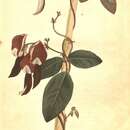en
names in breadcrumbs


Kennedia rubicunda, commonly known as the dusky coral pea,[2] is a species of flowering plant in the family Fabaceae and is endemic to eastern continental Australia. It is a twining or prostrate herb with trifoliate leaves and dark red or purple flowers.
Kennedia rubicunda is a twining or prostrate herb with stems up to 4 metres (13 ft) long and covered with rusty-brown hairs. The leaves are trifoliate on a petiole 10–50 mm (0.39–1.97 in) long, the leaflets egg-shaped to lance-shaped, 30–120 mm (1.2–4.7 in) long and 20–80 mm (0.79–3.15 in) wide with lance-shaped stipules 2–4 mm (0.079–0.157 in) long at the base of the petiole. Dark red pea flowers are arranged in racemes of up to twelve on a peduncle 20–70 mm (0.79–2.76 in) long, each flower on a pedicel 10–20 mm (0.39–0.79 in) long. The sepals are 10–15 mm (0.39–0.59 in) long and densely covered with rusty-brown hairs and the petals are 30–40 mm (1.2–1.6 in) long. Flowering mostly occurs from September to December and the fruit is a rusty-hairy, flattened pod 50–100 mm (2.0–3.9 in) long containing ten to fifteen seeds.[2][3][4][5]
Dusky coral pea was first formally described in 1793 by Dutch botanist George Voorhelm Schneevoogt, who gave it the name Glycine rubicunda in his book Icones Plantarum rariorum.[6][7] In 1804 it was published under its current name by French botanist Étienne Pierre Ventenat in his book, Jardin de la Malmaison.[8][9] The specific epithet (rubicunda) refers to the species' red flowers.[10]
Kennedia rubicunda is widespread in a variety of habitats, including in forests and rainforest margins, on the coast and nearby tablelands of Queensland, New South Wales and far eastern Victoria.[2][3][11] It is an introduced species in India, Tasmania and the North Island of New Zealand[12] (where it is considered a weed).[13]
Flowers of K. rubicunda are pollinated by birds.[14] Seed dispersal by ants (myrmecochory) has been reported,[15] in which ants are attracted to fatty acid-rich elaiosomes attached to the outside of the seeds.[16] The plant is killed by bushfire but regenerates from seed dormant in the soil and is often abundant after fire.[3][17] K. rubicunda forms a symbiosis with soil nitrogen fixing bacteria (rhizobia) resulting in the formation of nodules on the roots that fix atmospheric nitrogen which is used for plant growth.[18]
This plant is noted for its vigour and can be used to cover embankments or structures.[19] The species is adapted to a range of well-drained soils and adapts to positions with sun or partial shade.[20] It is resistant to drought and has some frost tolerance.[20] The species can be propagated by scarified seed or cuttings of semi-mature growth.[20]
Kennedia rubicunda, commonly known as the dusky coral pea, is a species of flowering plant in the family Fabaceae and is endemic to eastern continental Australia. It is a twining or prostrate herb with trifoliate leaves and dark red or purple flowers.